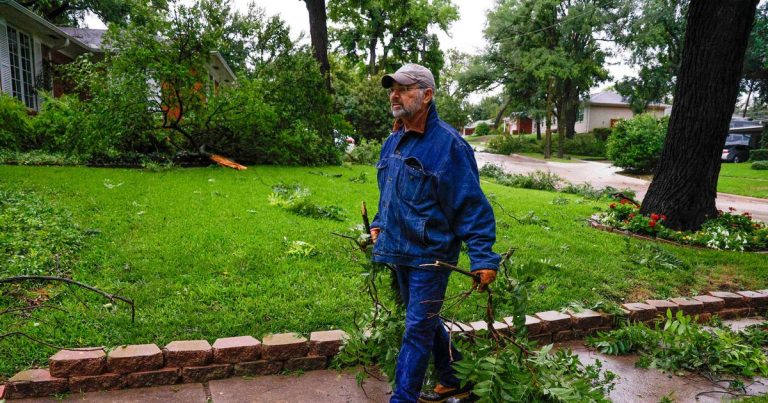Less than 24 hours later, multiple storms bringing heavy rain, hail and winds gusting more than 70 mph struck Dallas, Houston and other parts of North and East Texas, leaving nearly 1.4 million customers without power. The storms in the Houston area came just 12 days after the city was hit by a derecho that killed eight people and brought wind gusts of 100 mph.
The storm knocked out power to about 400,000 customers in Dallas County and more than 280,000 customers in Harris County, where Houston is located. Dozens of counties southeast of Dallas and north of Houston experienced widespread outages affecting 30 to 60 percent of all customers.
Additional storms are possible across West and South Texas through Tuesday evening.
Dallas was hit by two complex storms within the space of about 12 hours, the first late Monday afternoon and the second before dawn on Tuesday.
Tuesday morning’s storm brought winds of more than 70 mph to Dallas and the surrounding area, with gusts of 83 mph recorded in Denton and gusts of 77 mph and 75 mph recorded at Dallas-Fort Worth International Airport and Love Field, respectively.
As these storms moved south, heavy rain, hail and multiple wind gusts of over 60 mph affected Lufkin and Cold Spring as they hurtled toward the Houston area, with wind gusts of 75 mph observed at George Bush Intercontinental Airport just north of Houston.
Reports of wind damage trickled in Tuesday afternoon from Houston to Lake Charles, where wind gusts of about 55 to 60 mph were common. The roof of a car wash collapsed in Kunze, northwest of Beaumont.
During the early morning storm near Dallas, the weather service received reports of downed trees and damaged buildings, including a roof that was torn off a commercial building near suburban Addison, about 13 miles north of Dallas. “Major damage” was reported at North Forney High School, about 23 miles east of Dallas.
Videos on social media showed heavy wind gusts blowing rain sideways and frequent flashes of lightning. Visibility at Dallas-Fort Worth International Airport dropped to zero during the storm. Similar scenes were seen in Houston, where visibility was reduced to low and skies turned dark in the mid-afternoon.
Monday’s Storm
The previous Monday afternoon, Dallas was hit by a lone supercell, or rotating thunderstorm, that formed directly above the city. One storm, over Tarrant County, just west of Dallas, dumped baseball-sized hailstones. Social media videos showed the hail shattering a skylight at a Walmart, raining chunks of ice and broken glass onto the store’s sales floor.
The weather service received more than 100 reports of large hail on Monday, mostly from northeast Texas.
While it was initially unclear how much damage had been done in the region, hail is the costliest hazard from severe thunderstorms in the Lone Star State, typically exceeding damage caused by thunderstorms and tornadoes.
Monday night’s hailstorm rose to heights of more than 60,000 feet and was visible from as far north as Oklahoma City, about 180 miles away.
Why do these storms keep happening?
The Texas storm is developing on the northern edge of a “heat dome,” or ridge of high pressure that’s parked over Mexico and bringing record temperatures to the country. Thunderstorms tend to straddle the edge of the heat dome, riding the boundary where temperatures change over distance. These so-called ridge runners also harness energy from the jet stream, mixing momentum at the surface in the form of straight-line winds.
Fortunately, the weather is expected to be relatively calm on Wednesday, but another wave of windy thunderstorms is expected to develop across the Colorado High Plains on Thursday and move southeast toward Dallas.

